This season, the Premier League title race is highly competitive. At the time of writing, Arsenal are in third place with 27 points from 12 games, level with Liverpool, who are second on goal difference. Manchester City lead the table with 28 points, one point ahead of their rivals, while Tottenham are in fourth place with 26 points, just behind the top three.
This tactical analysis examines a factor that could be crucial in the competition of the most challenging league in the world: set pieces. Arsenal are currently the best in England’s top flight at scoring from set pieces, with eight goals out of 26, representing about 31% of their total goals. Of these eight goals, six were from corner kicks, making them the most productive from corners.
In the summer of 2021, Mikel Arteta brought Nicolas Jover, who was with him in Man City’s coaching staff as a set-piece coach, to Arsenal. “After looking through what the best solution would be, a person that I know was on the market was available,” Arteta said. “He is someone whose expertise is incredibly useful and valuable for us. He’s joining us. His name is Nicolas Jover, and I’ve worked with him before at City.”
This scout report will show Arsenal’s diverse tactics at attacking corners.
The area after the far post
They prefer to start their corner routine with many players standing together in a pack after the far post, which gives them many advantages to target the far or the near post, and we will explain it in detail. Let’s start with how they use this pack to target the far post.
They target the area after the far post with a simple and effective idea: using this pack to move to the near post, dragging the man-markers and blocking anyone from the opponent, trying to step back to free space behind them to the last player they leave. Let’s take an example.
In the first photo, Sevilla FC defend with five players in the first zonal line: a player in front of them to defend the flick and to go to defend the short corner if it happens, a player to defend the rebound and four man-markers. Arsenal attack the box with six players, which means that two players are free, Ben White and Kai Havertz.
In the second photo, Arsenal players move to the near post, but some have specific roles. Gabriel Magalhães blocks the goalkeeper to prevent him from getting the cross in the air and to make him late to close the far post against the headed shot later.
In contrast, Takehiro Tomiyasu blocks the last zonal defender, preventing him from stepping back. As shown in the third photo, Ben White is doing the same block to Tomiyasu’s marker, who may leave him to return to the targeted man, Kai Havertz.
In the fourth photo, the plan works, so Havertz gets the ball easily in ample space.
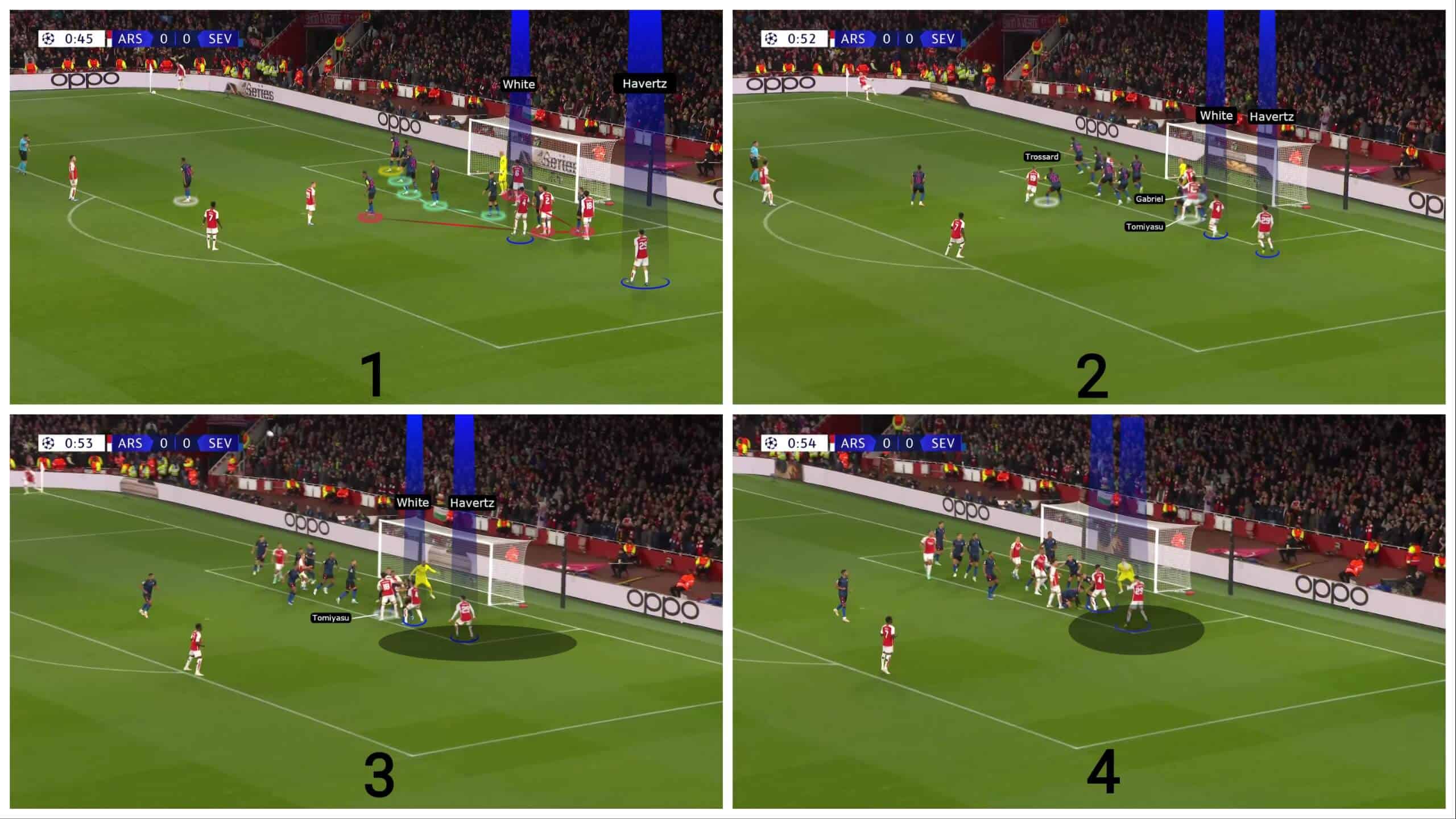
But the ball goes beside the post, as shown below.
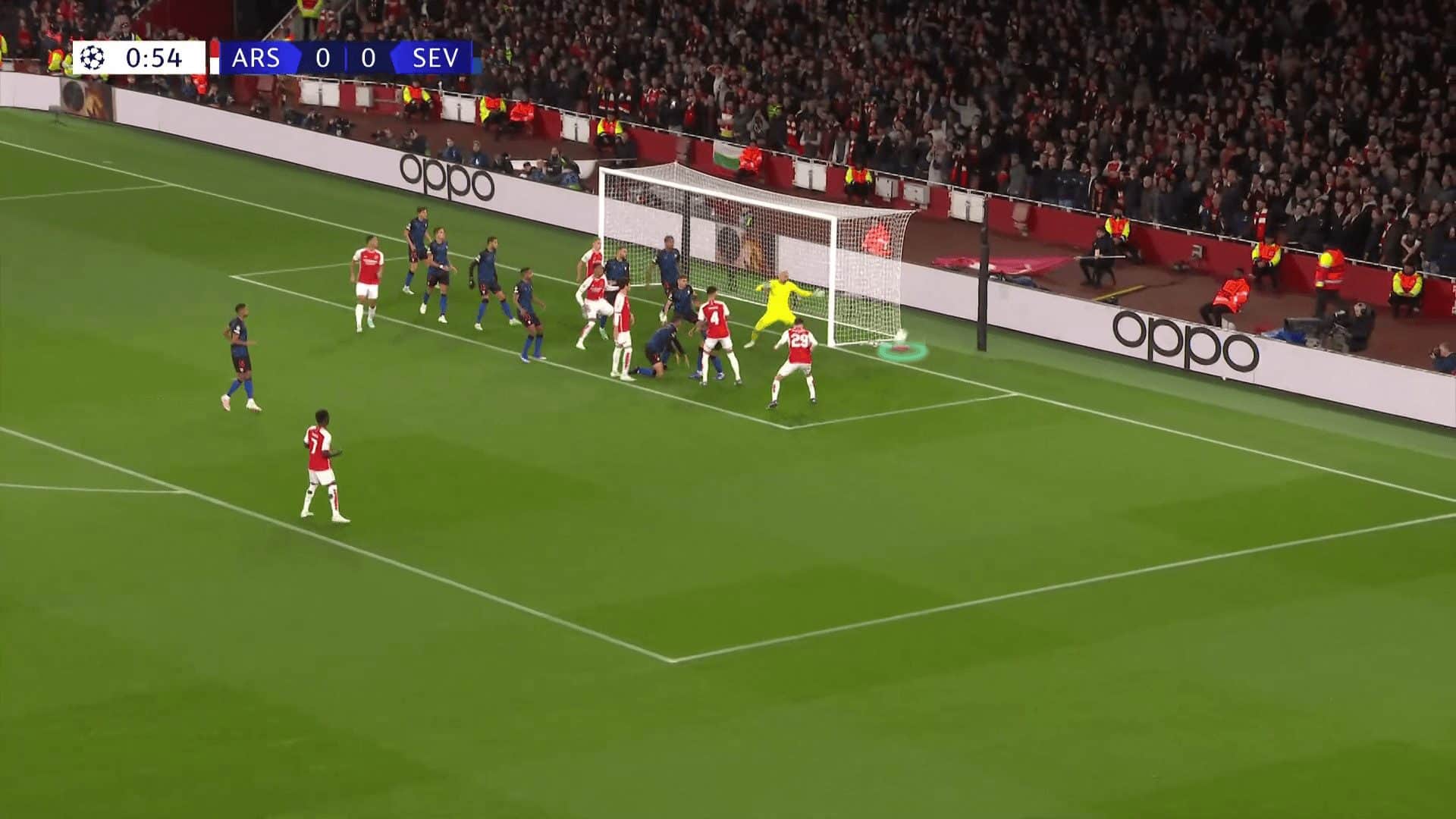
Against Man United, they used a similar idea, but Man United had only three man-markers, so there were three free attackers, as shown in the first photo.
In this first photo, an attacker blocks the goalkeeper, dragging his man marker, and two players go toward the near post dragging their man-markers, so Christian Eriksen( who defends the rebound) tries to step back, but he can’t reach the ball, as shown in the second photo.
In the second photo, there is only the last zonal defender against three free attackers, so one of them gets the ball, winning the aerial duel because he jumps from a free movement, which is a dynamic mismatch. The remaining two attackers can get the ball if it passes, as shown in the third photo.
The ball goes up above the crossbar, as shown in the fourth photo, maybe because of the duel with the last zonal defender, so they improve it later in this match, as we will explain in the next case.
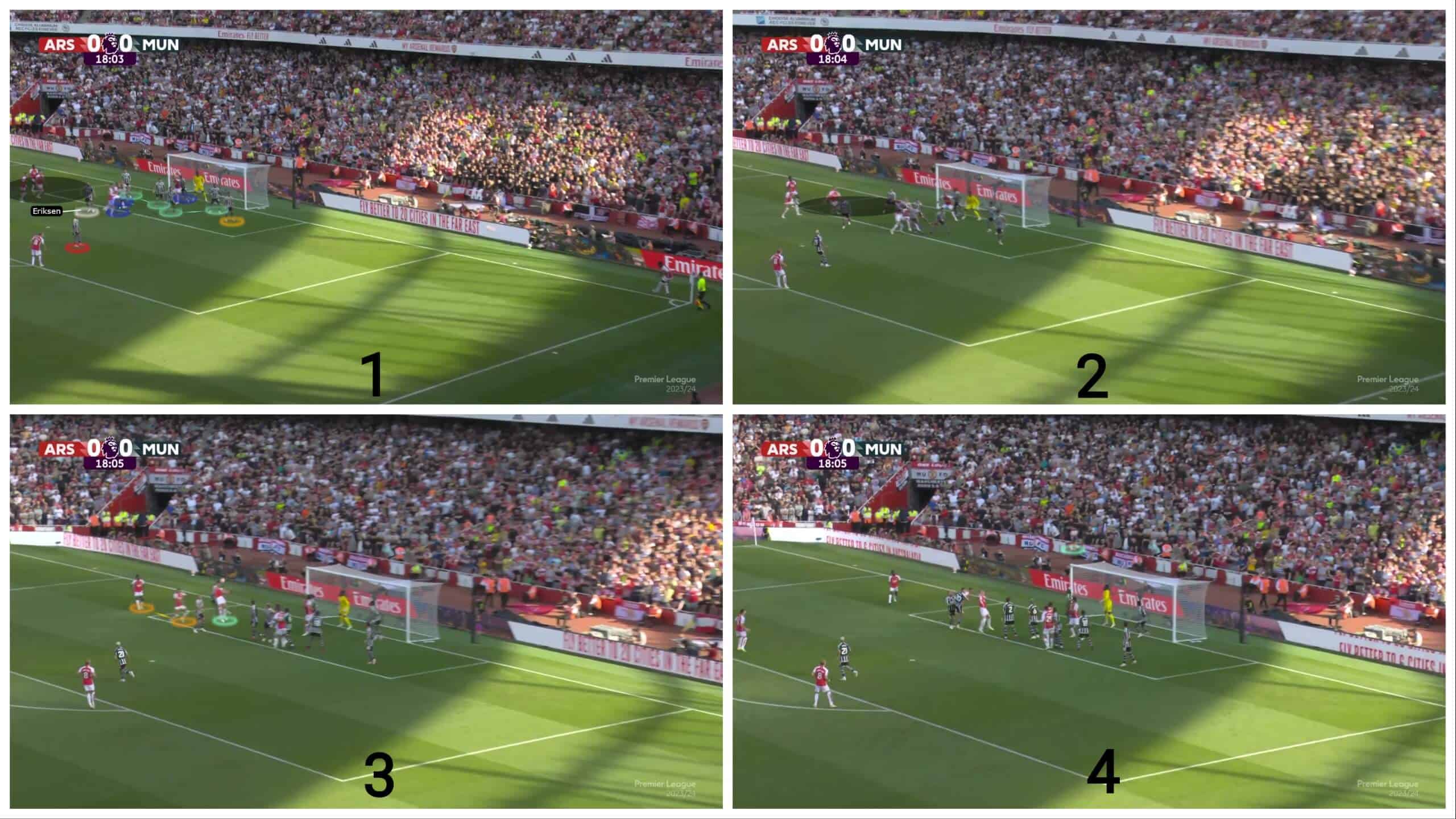
In the first photo, Arsenal use a short-option attacker to force Eriksen to stick to the rebound zone, so they have two free attackers.
In the second photo, as the taker moves, three attackers move, in green arrows, to receive the headed pass if the targeted player can’t play it directly to the goal, leaving only Gabriel Magalhães and Declan Rice, the targeted player.
In the third photo, Gabriel has a different role, which is blocking his man marker, preventing him from going back, but he also drags him toward the last zonal defender to take his attention, cutting the way from him to Rice, and he brilliantly succeeds in the fourth photo.
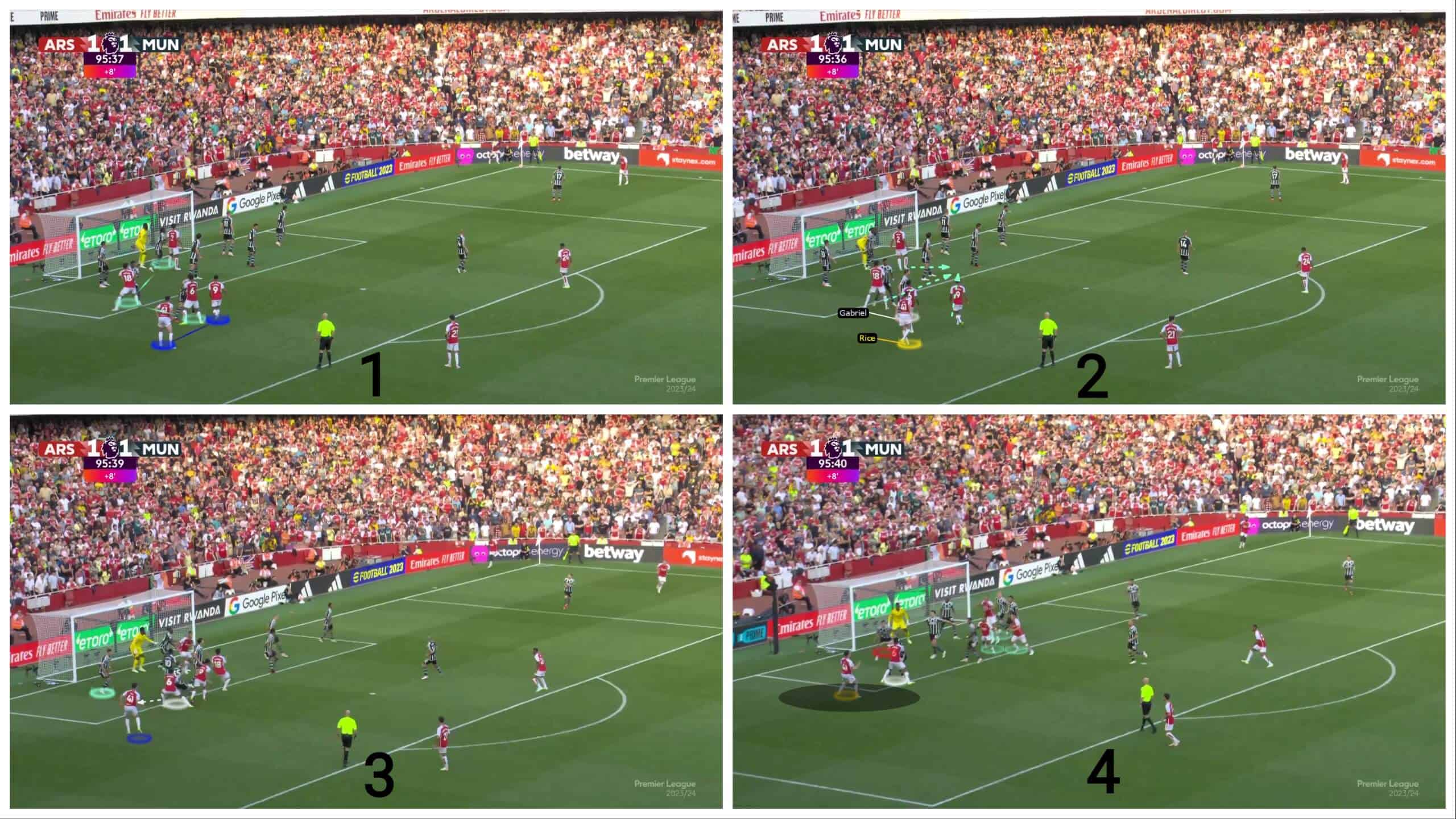
But the cross is a little more powerful, so he has to receive the ball first, then shoots, as in the two following photos, while Gabriel still cuts the way to him.
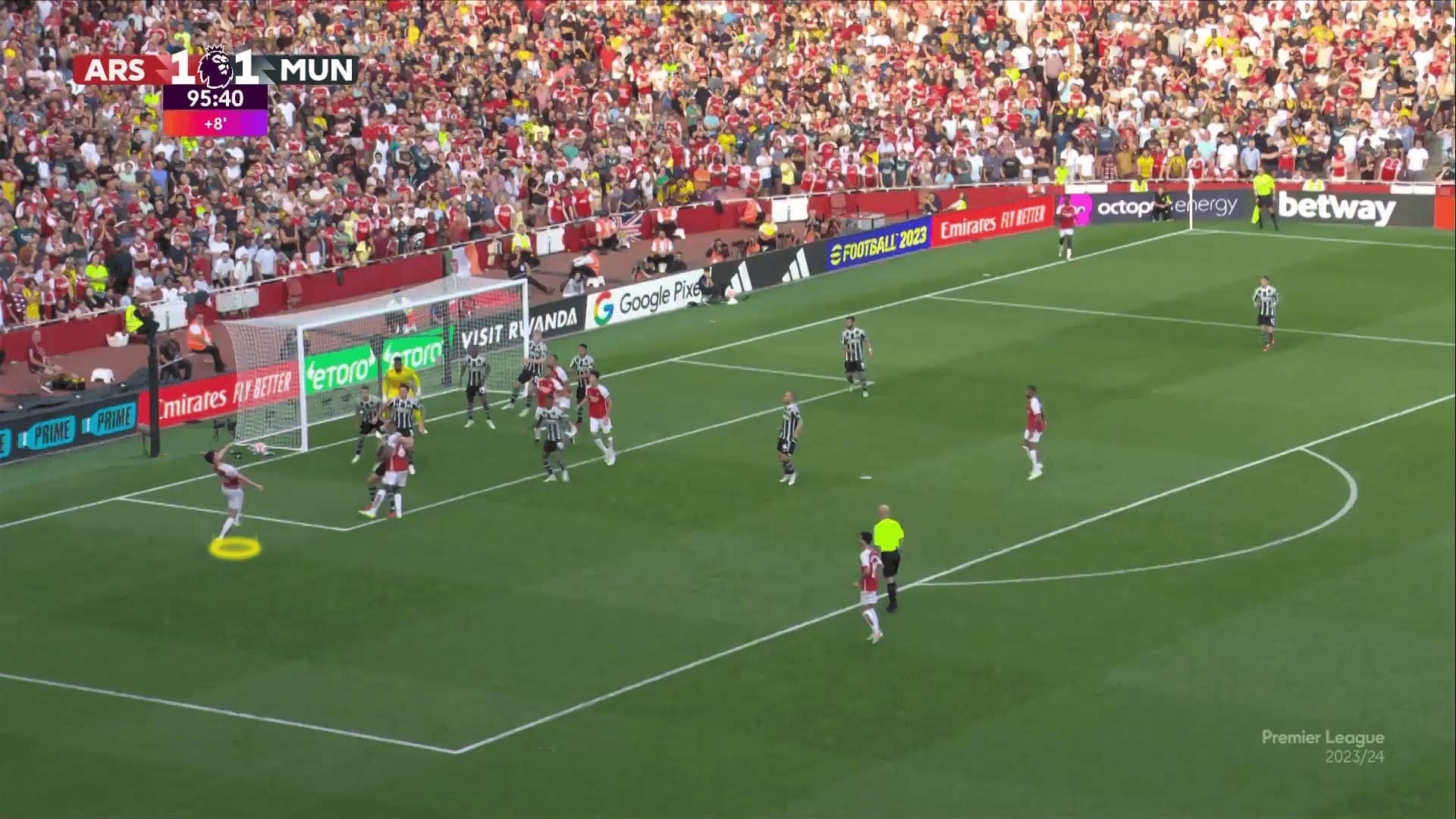
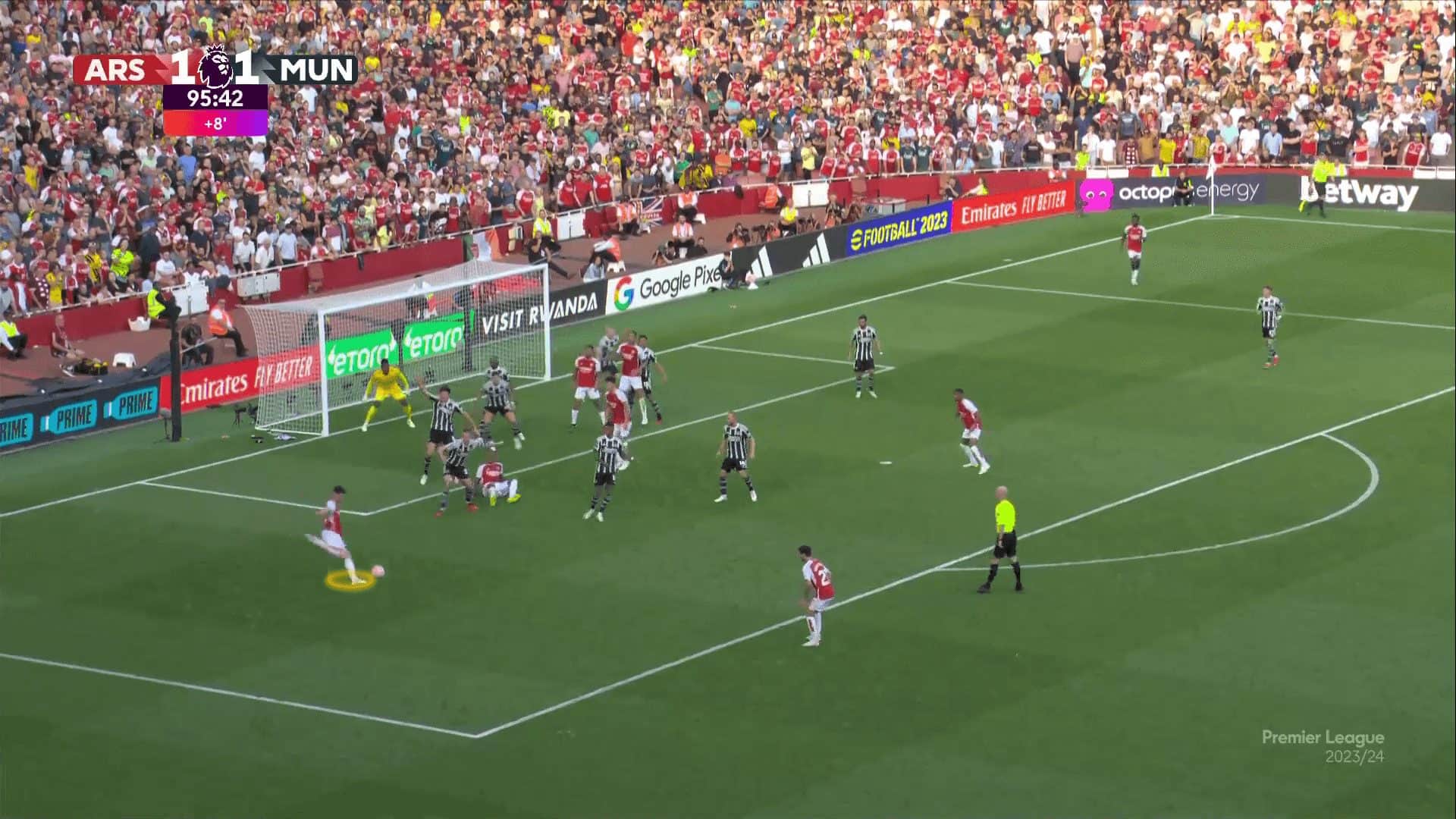
The result is an important goal, as shown below.
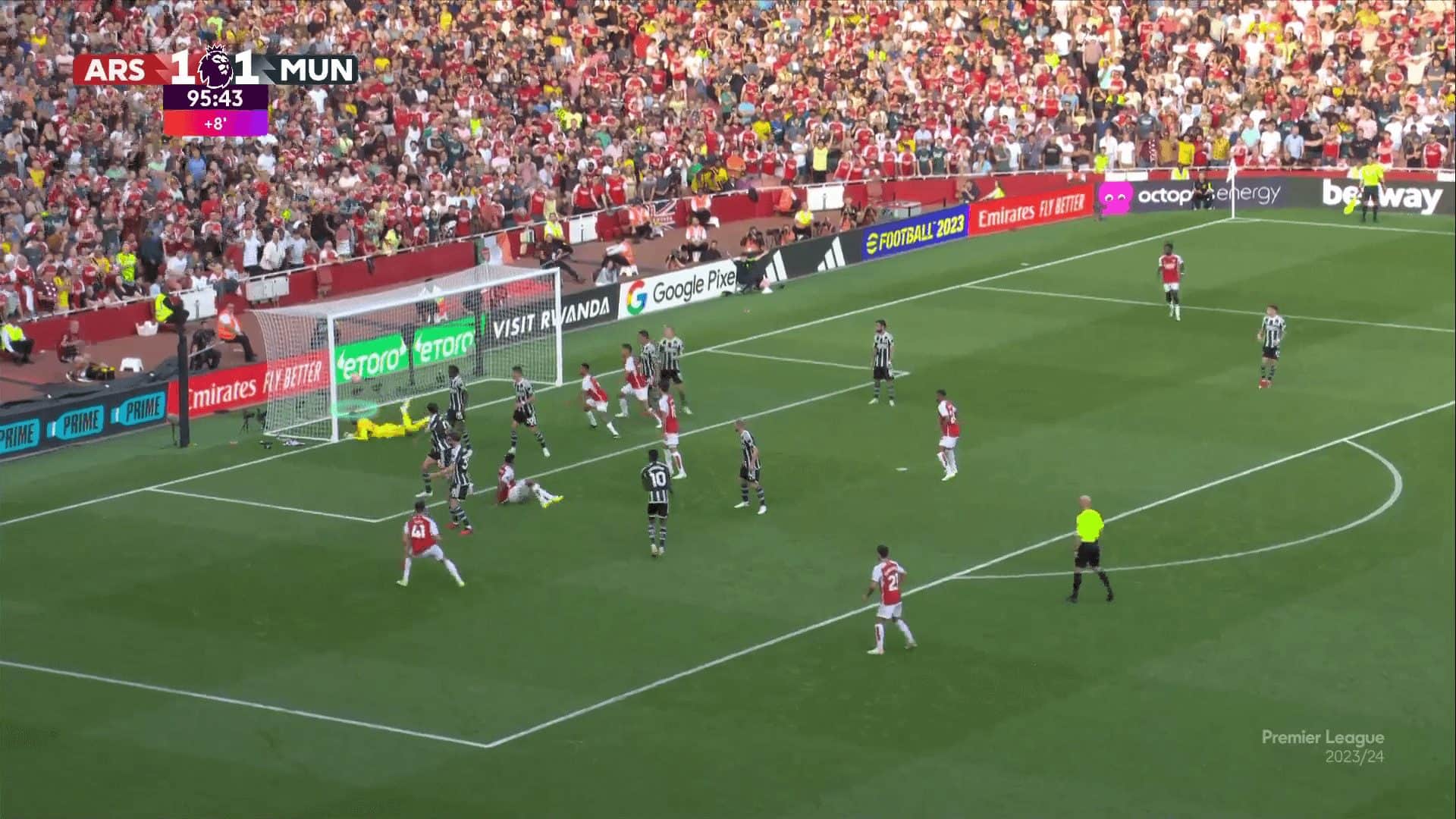
Overloading the near post
They also use this pack to target the near coming from the blind side of the near-post defenders, which causes an orientation problem for the defenders. They also come from a movement, so they can jump higher than the defenders who jump from a steady state; this causes a dynamic mismatch. Let’s take an example.
In the first photo, Spurs defend with five players in the first zonal line, four in the second zonal line and a short-option defender.
In the second photo, the six attackers move in different ways when the taker moves, so let’s track them. Ben White stands next to the goalkeeper to block him, preventing him from getting out to get the cross or the headed pass to the far post. At the same time, Eddie Nketiah stays on the far post to get the headed pass and flick if the first targeted player can’t shoot directly, so there are four remaining attackers who target the far post.
In the third photo, it seems that Tottenham have enough players to defend the near post, but three attackers target only one defender because they come from the back, so they can measure the ball in the air coming from the defender’s back while an attacker targets the area behind them, as shown in the fourth photo.
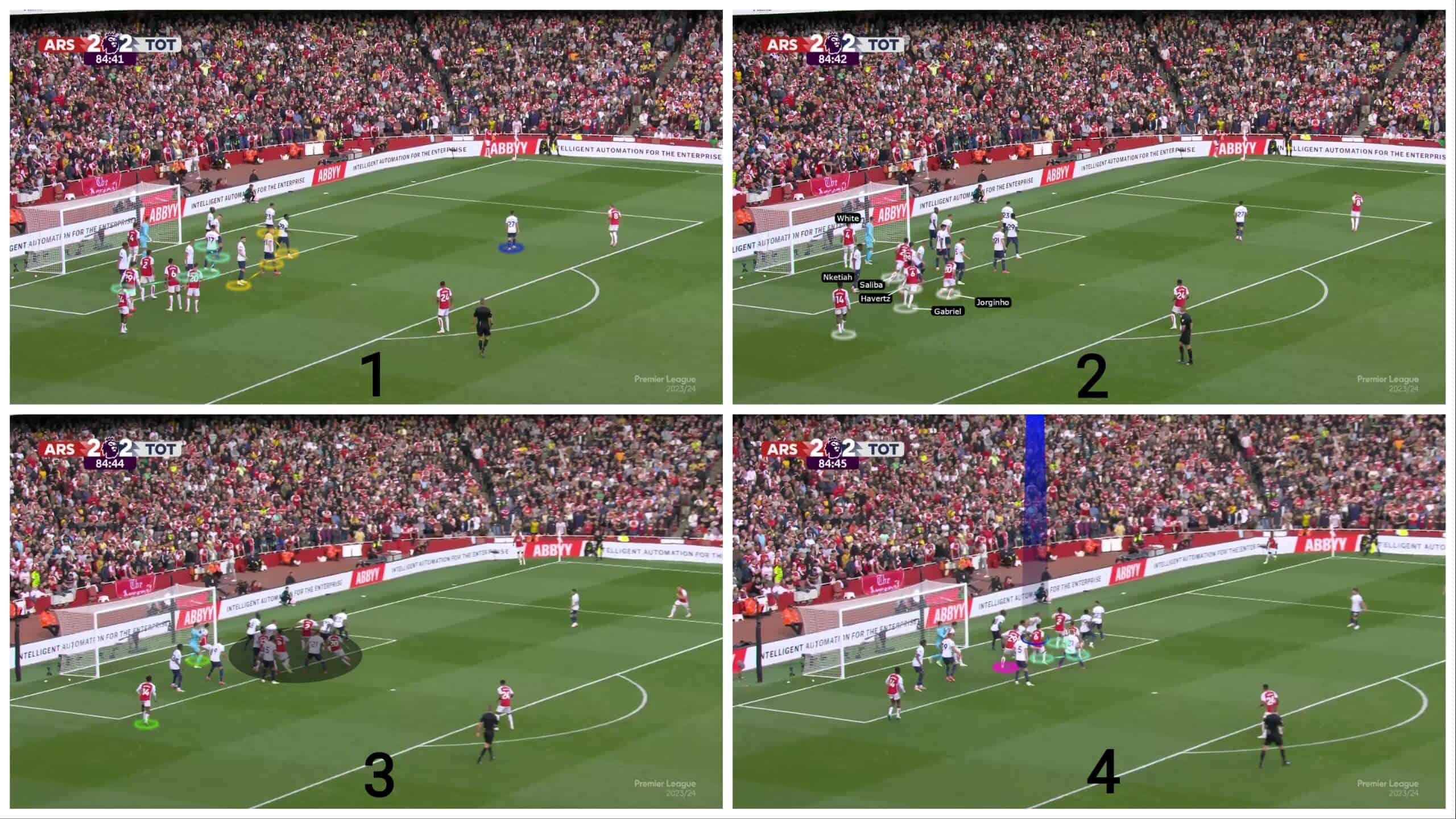
In the photo below, the three attackers overload the near post against only one defender, so his mate, in yellow, comes to help, leaving the space behind him for Havertz, who waits in case the ball drops there.
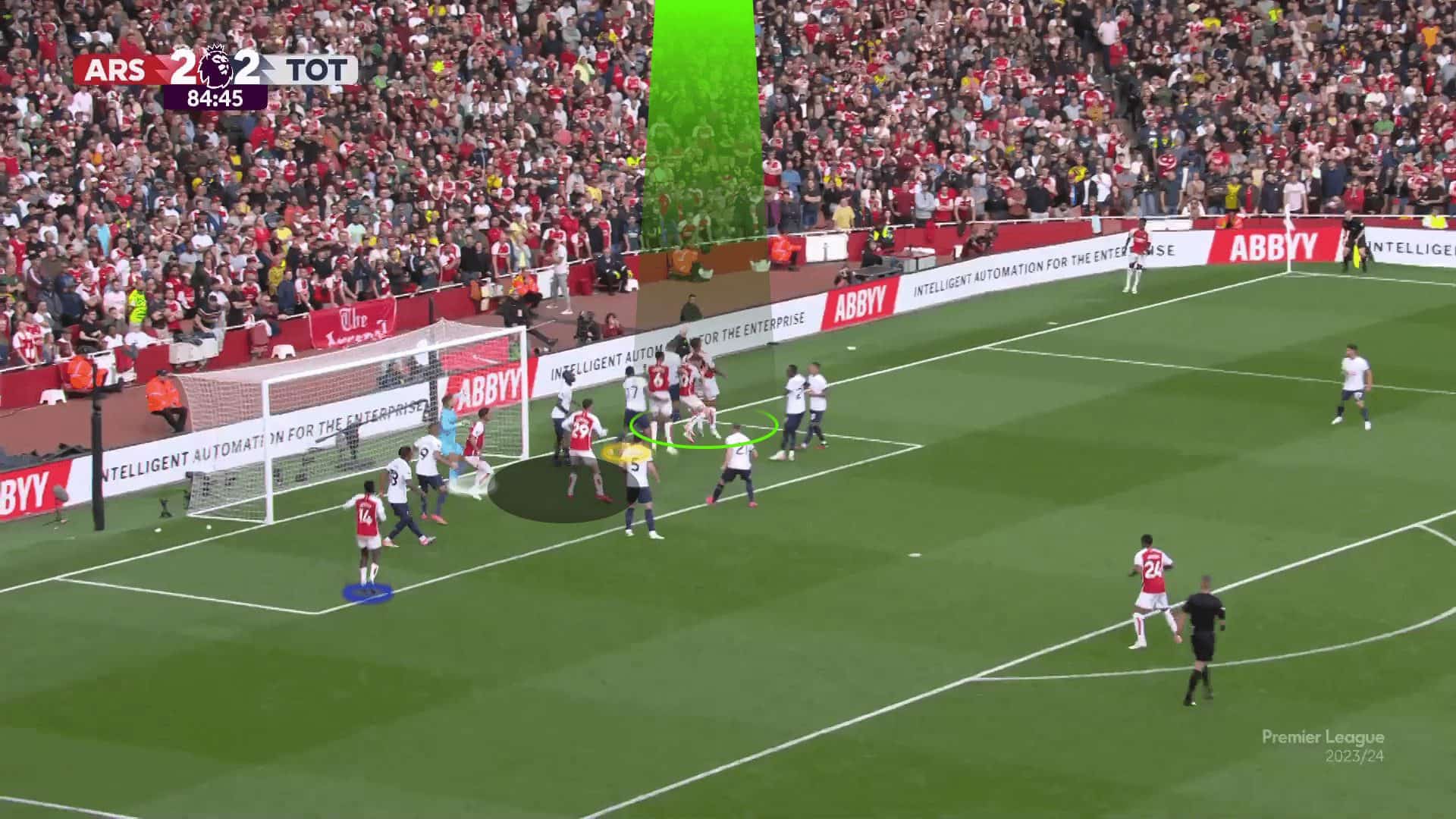
But the ball hits Gabriel’s back, not head, so it goes out beside the far post, as shown below.
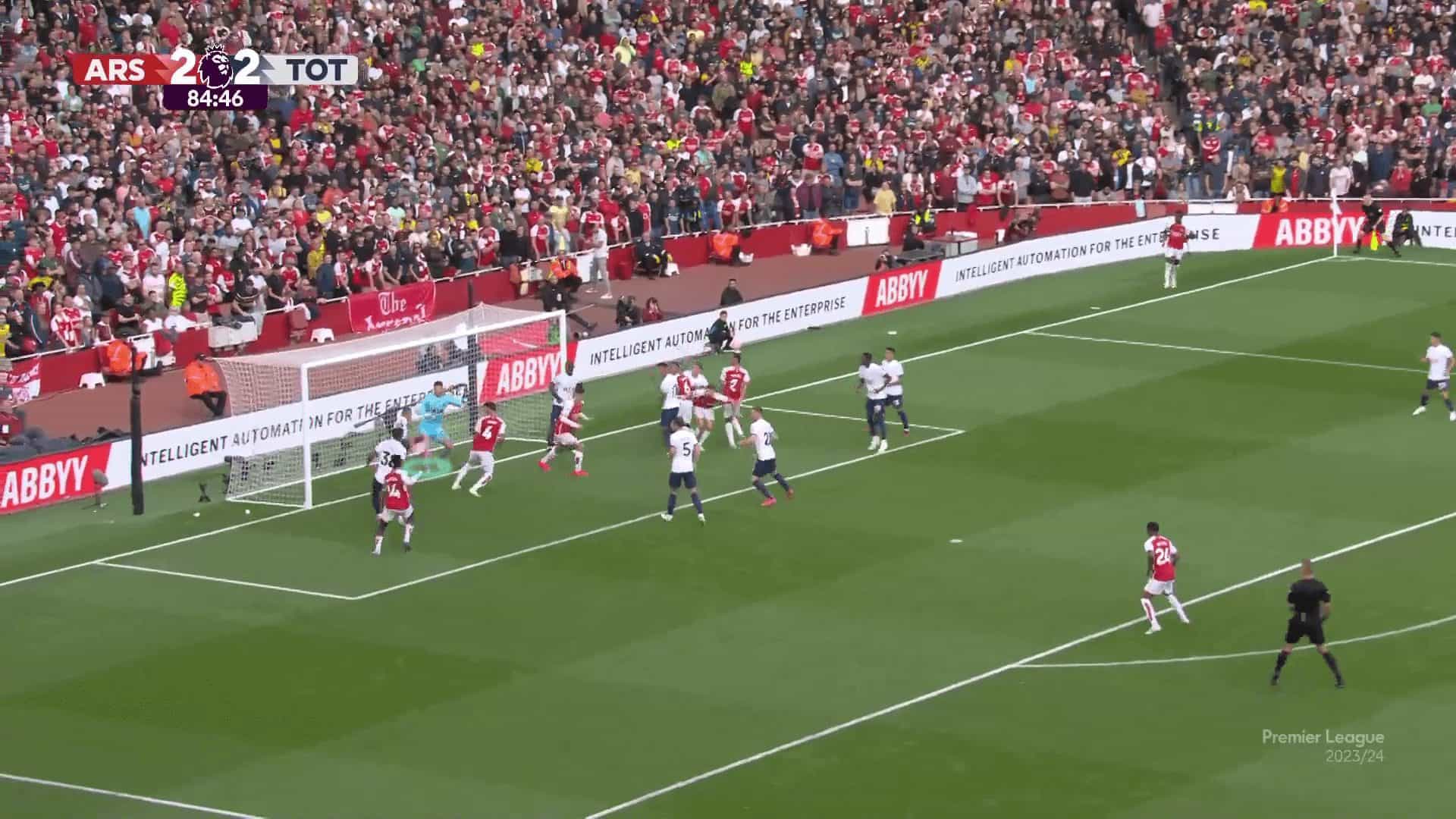
In their game against Burnley, they used a similar idea. Let’s know how!
As shown below, Burnley defend with five zonal players, three man-markers, a rebound player( in pink) and a short-option defender out of the shot. We know that Arsenal usually use six players inside the box, so there are three attackers free, Rice, Gabriel Martinelli and Havertz, who will come free, causing chaos, as we will explain.
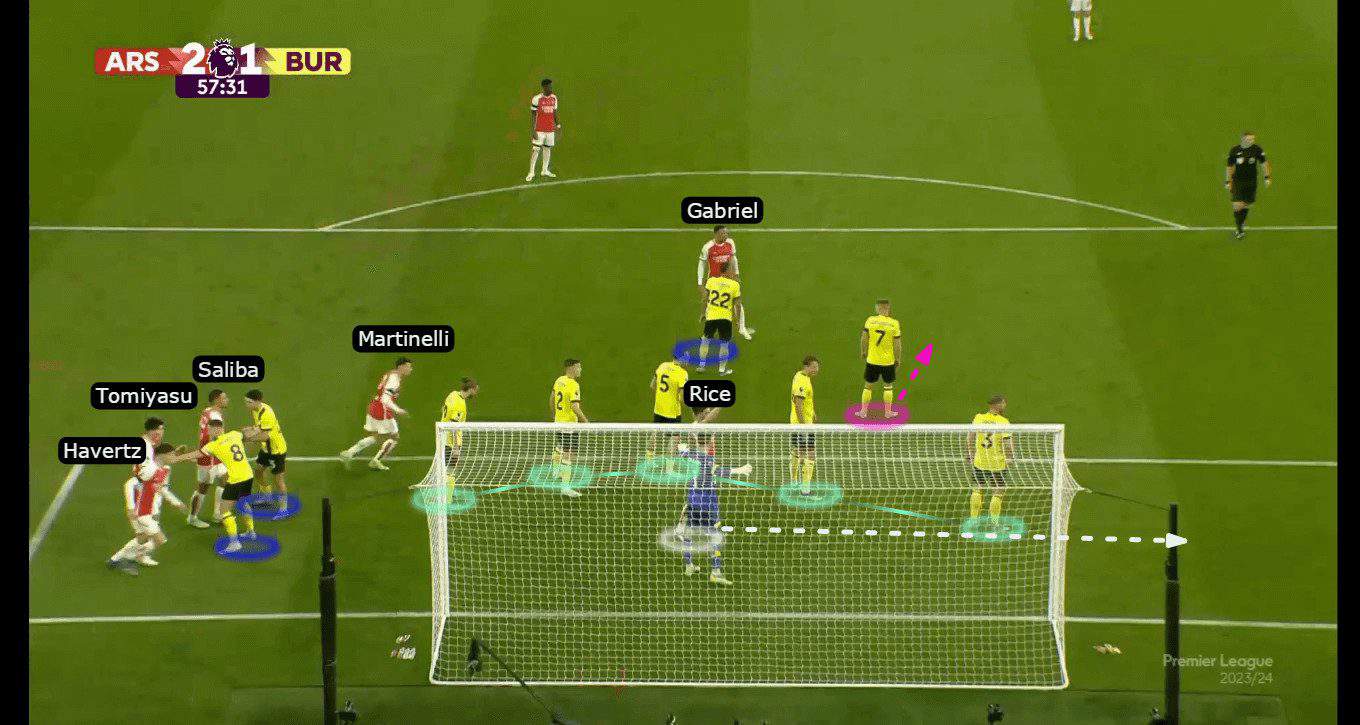
In the first photo, Rice goes to the area before the near post to drag the first zonal defenders, which causes gaps between zonal defenders, so they need to shift, which is one of the most dangerous and risky things in zonal defending because opponents may fill the gaps due to this unorganised shifting, as Arsenal do in this case. Martenilli goes in the gap behind Rice, Gabriel pushes his man marker to Join Havertz in the gap after Martinelli, William Saliba blocks the goalkeeper behind them, and Tomiyasu goes to the far post, as shown in the second and third photos.
This is called framing the goal to increase the possibility of getting the ball, so overloading the near post makes the middle empty for Saliba, who gets the ball scoring the goal, as shown in the fourth photo.
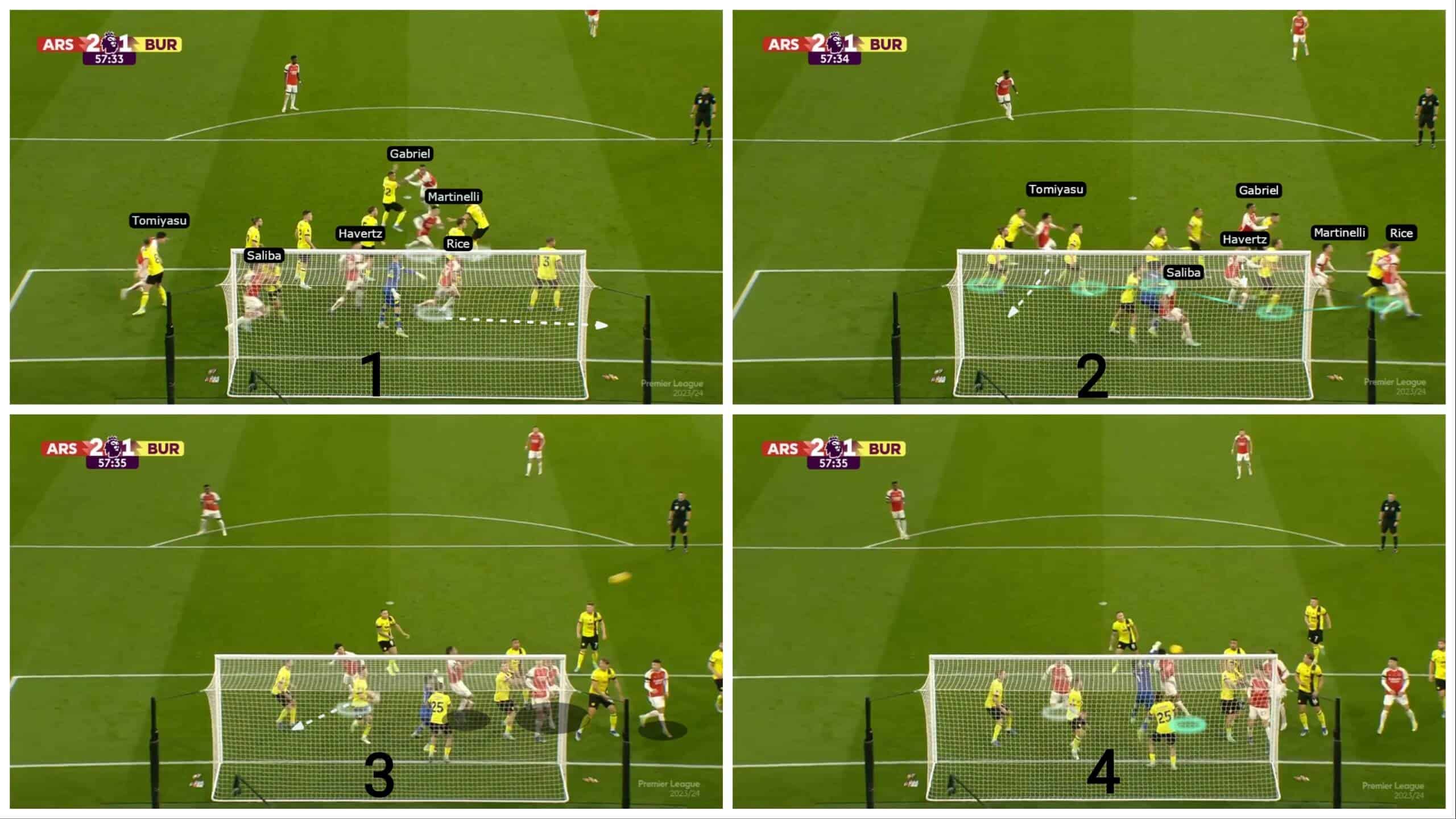
Short corners
This pack on the far post attracts the man-markers, so it gives a large space in the short and near-post area, so Arsenal made the best use of that.
In the first photo, our usual pack is shown. In contrast, Man United’s system against short corners is shown in the second photo; the blue player goes to defend the short-option attacker, who is usually Martin Ødegaard, in this example. In contrast, the green player goes to help him, and the yellow player defends the rebound zone, but Arsenal have a trick here.
Eddie Nketiah comes suddenly from the pack to receive the short pas. At the same time, Rice comes also to play a significant role, which is fixing Eriksen, who is forced to go to help, preventing anyone from going to the short area to make it a 3-v-2 situation, as shown in the third photo.
In the fourth photo, Nketiah receives the pass, then passes again to Martinelli, exploiting the 2-v-1 situation while Rice’s position makes anyone hesitate to help.
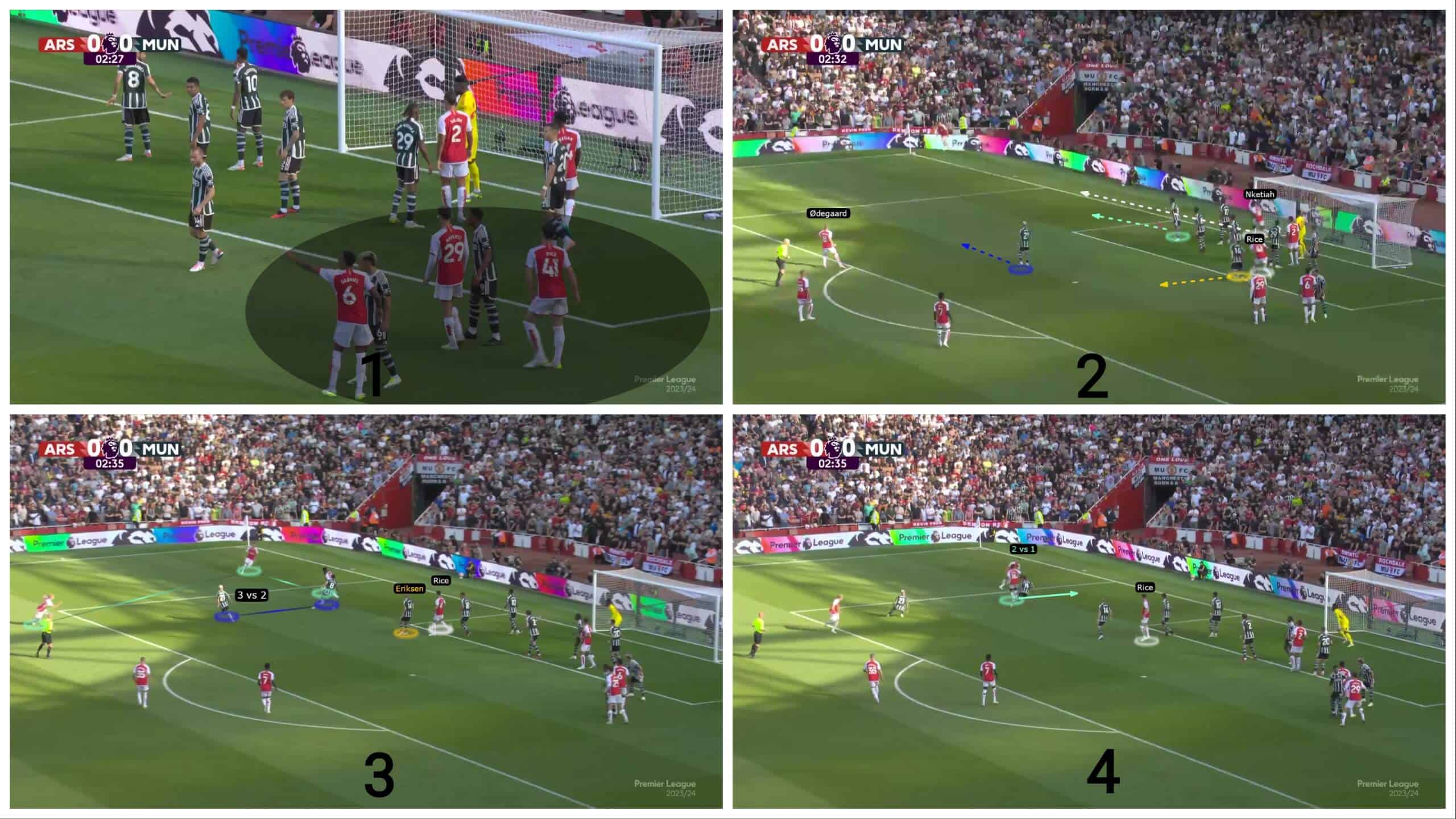
Martinelli gets the ball in a good space, having options to pass on the near and the far post, while he can also do a cut-back pass while having three players for the rebound, as shown below.
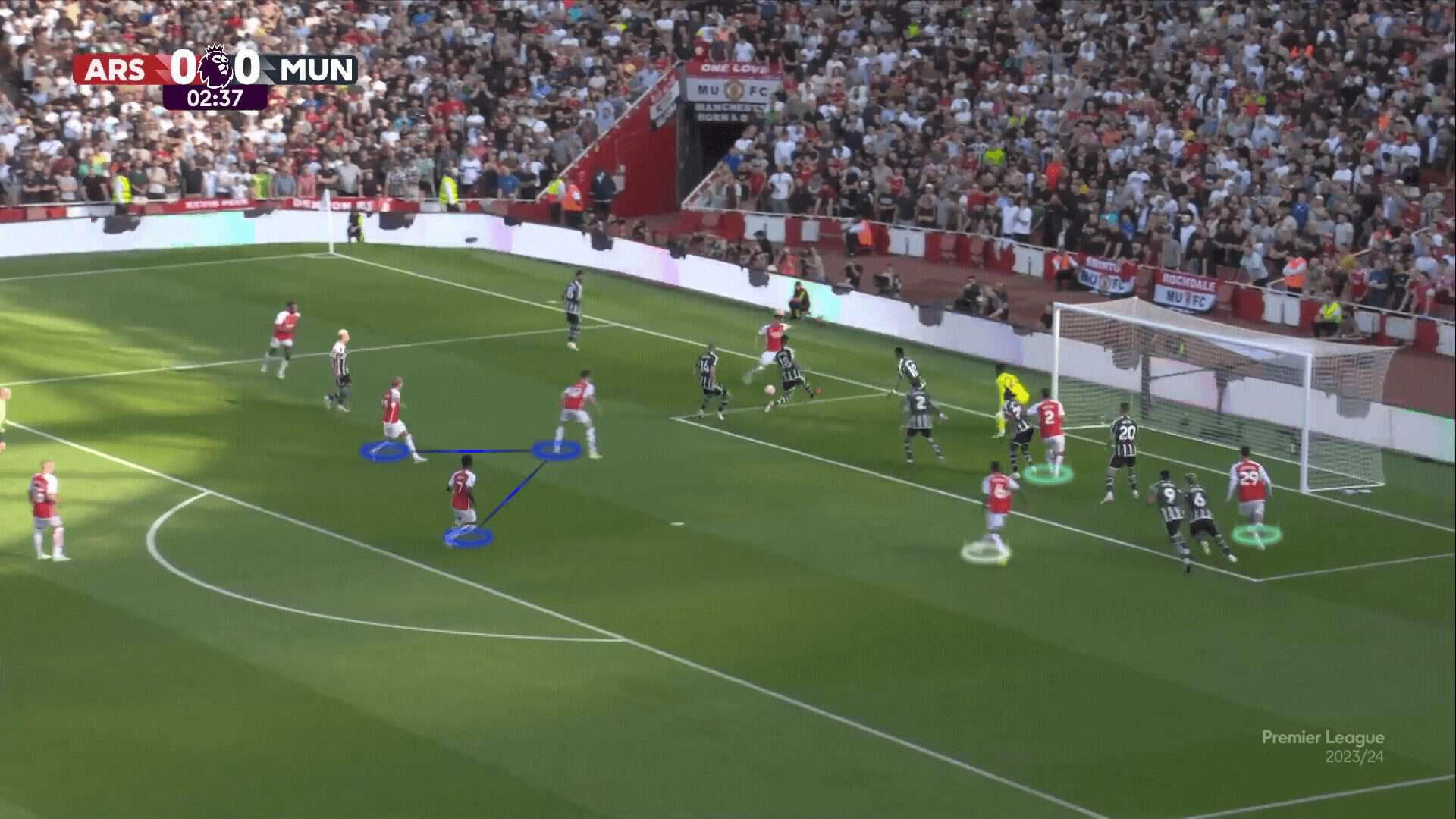
But he chooses to shoot directly, and the ball hits the defender, as shown below.
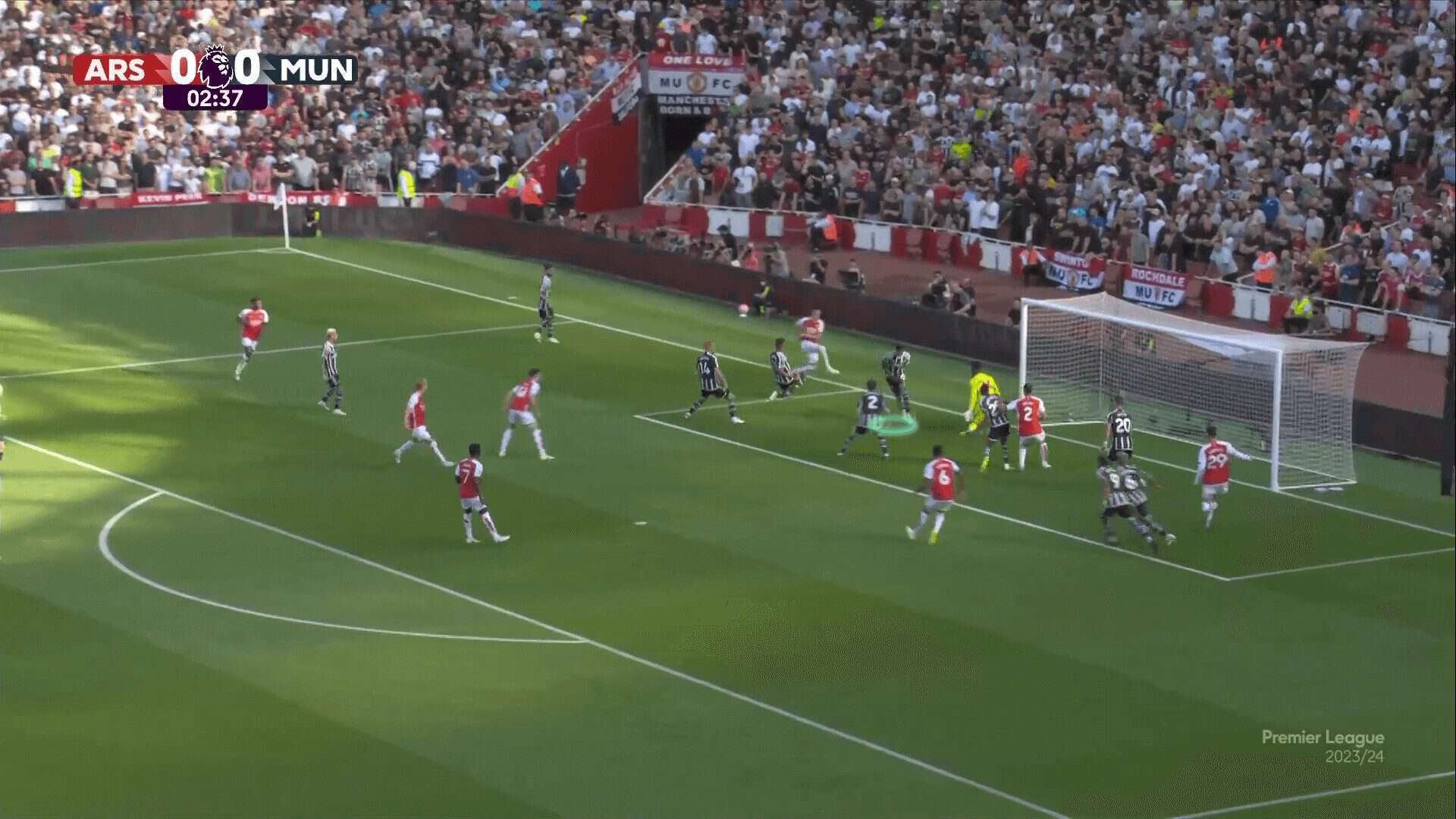
In the same match, they have another idea for the short corner, asking Ødegaard to come next to the taker to receive a short pass from the beginning. It sounds like Man United don’t have the previous problem because they have three defenders who can defend the short and rebound area from the beginning, as shown in the first photo. Still, it is Nketiah’s role to come from the box behind them to make it a 4-v-3 situation to force Eriksen to go to him, which opens the path of a pass to the rebound zone, as shown in the third photo.
In the fourth photo, the plan works, so Martinelli gets the ball in the rebound zone.
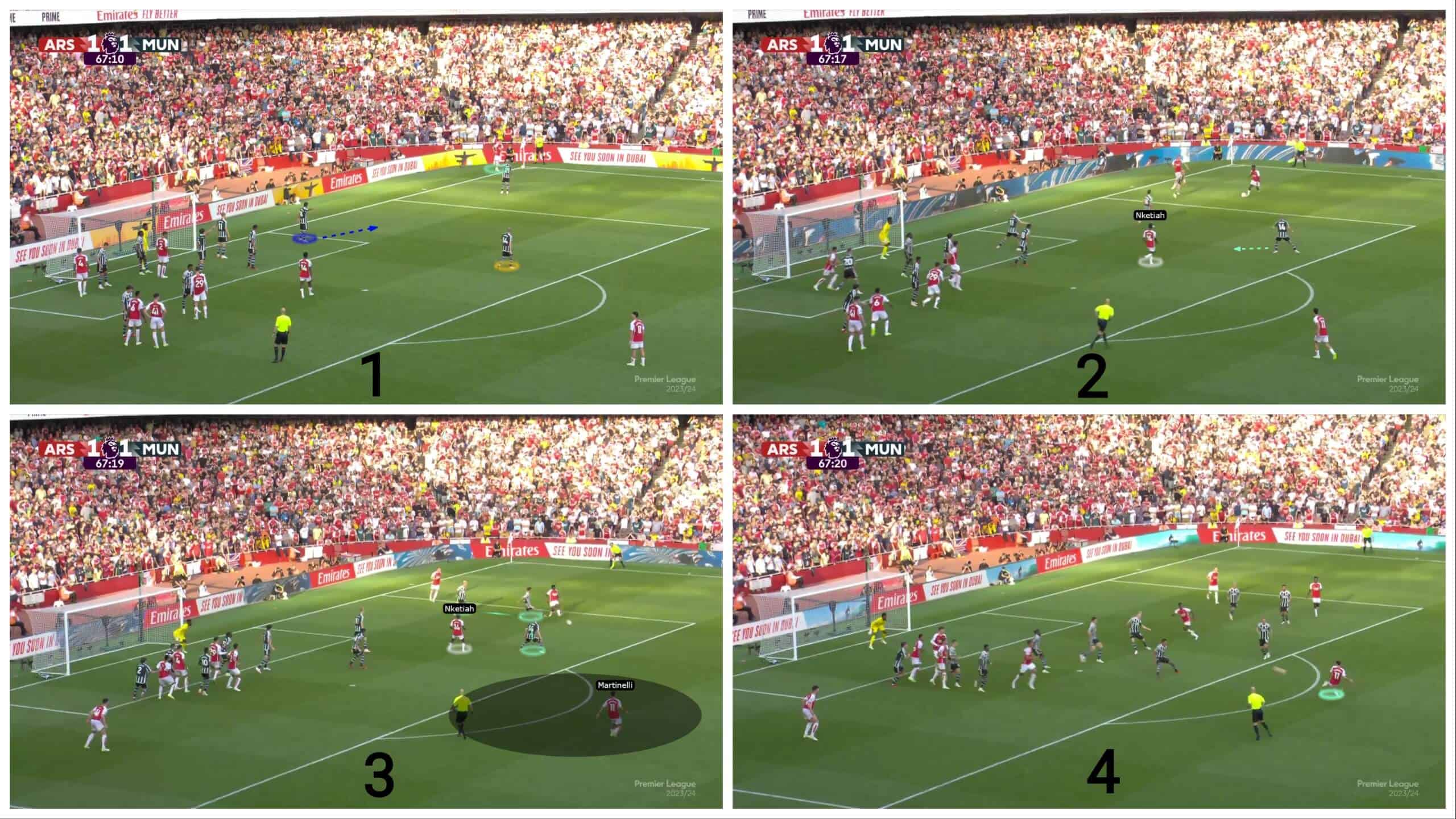
The shot is excellent but goes next to the post, as shown below.
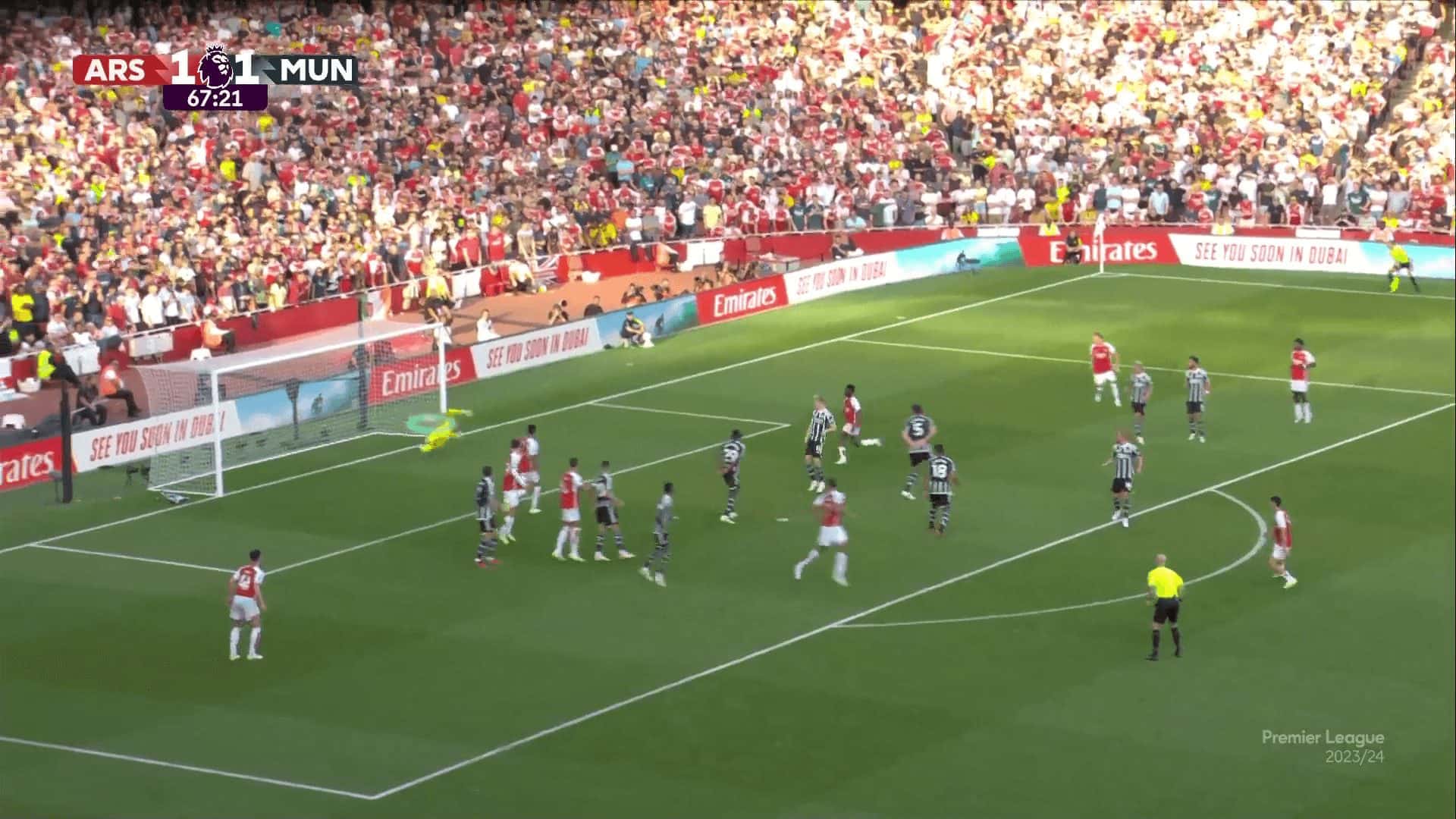
Counter ideas
Opponents have tried to find counter ideas to defend against the pack Arsenal use.
One of the best defending schemes against Arsenal was Fulham’s having five players in the first zonal line, one in front of them, three in the second zonal line and a short-option defender, as shown in the first photo.
This second-zone line has a defending trick, making him effective against targeting the near and the far post. If Arsenal targets the far post, the last defender in the second line helps the last one in the first zonal line, unaffected by the pack’s movement, as in the second photo.
If Arsenal targets the near post, the last defender in the second zonal line blocks the last attacker moving to the near post, preventing him from going to the near post, making them lose the numerical mismatch, as shown in the third and fourth photos.
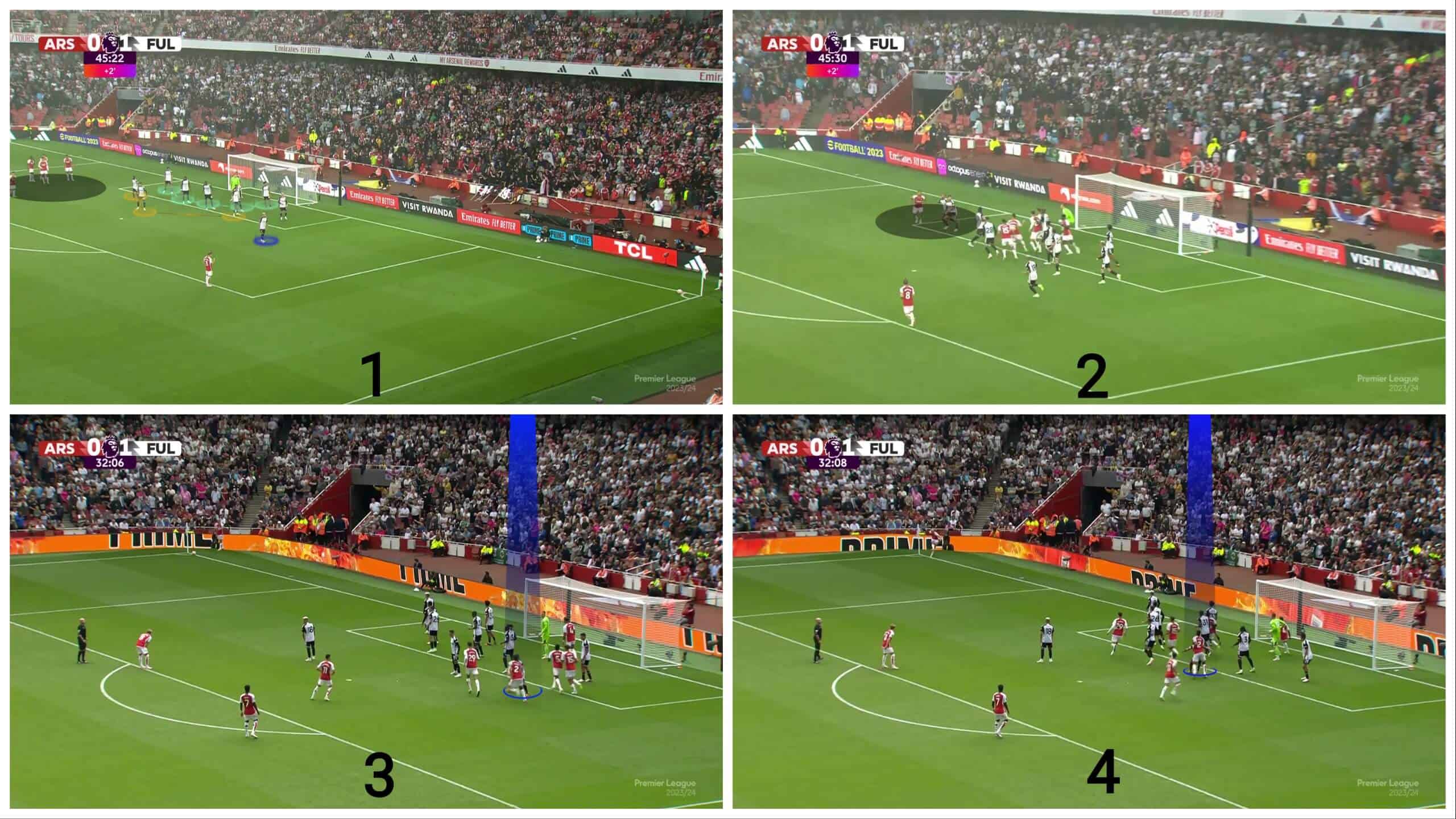
As shown below, the last zonal defender of the second line can block the last attacker while the remaining two of the second zone line go to help on the near post.
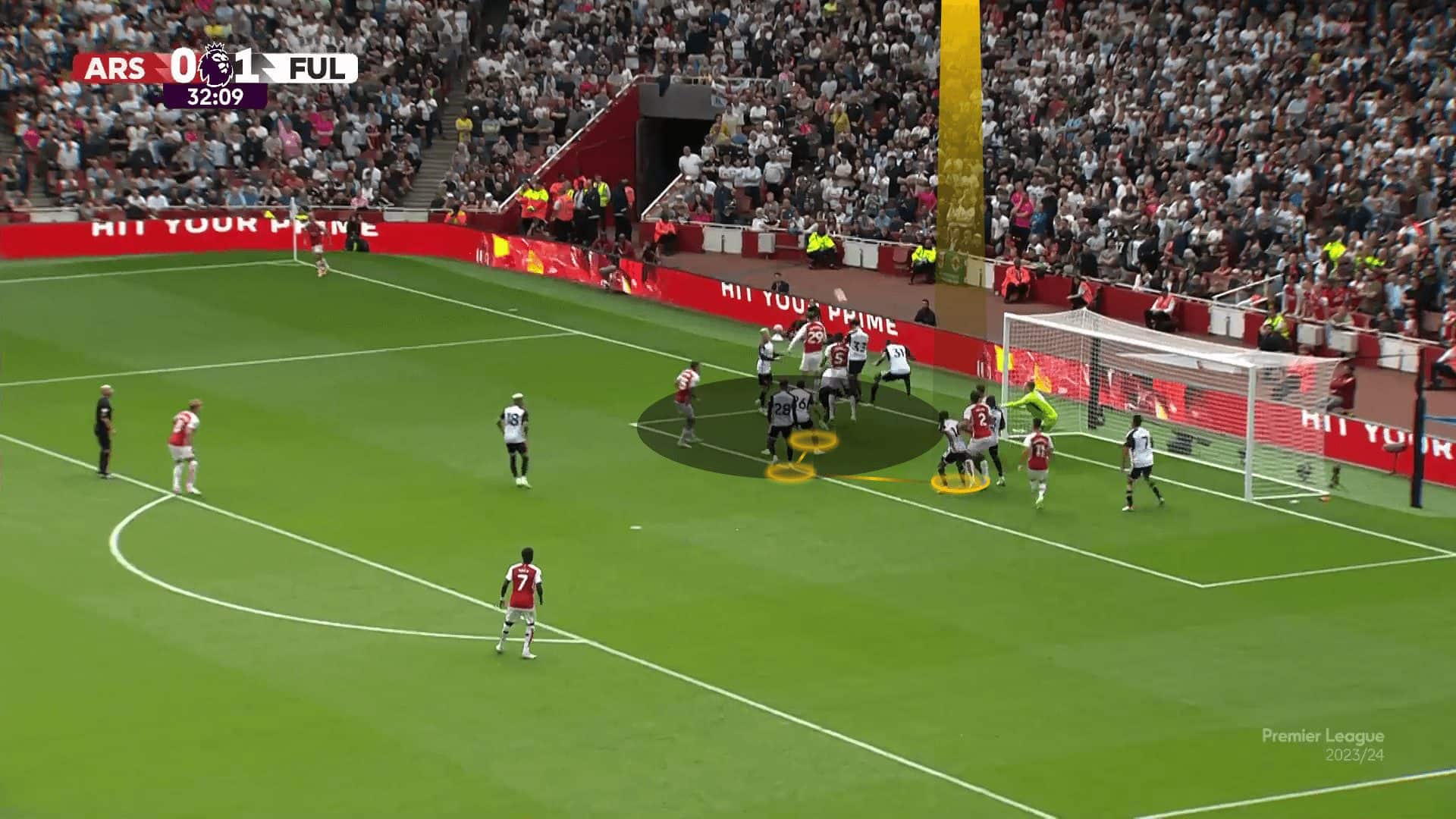
One of the solutions against overloading is increasing the man-markers, as shown in the photo below, where Brentford defend with only four zonal players, four man-markers, a short-option defender, and a rebound defender.
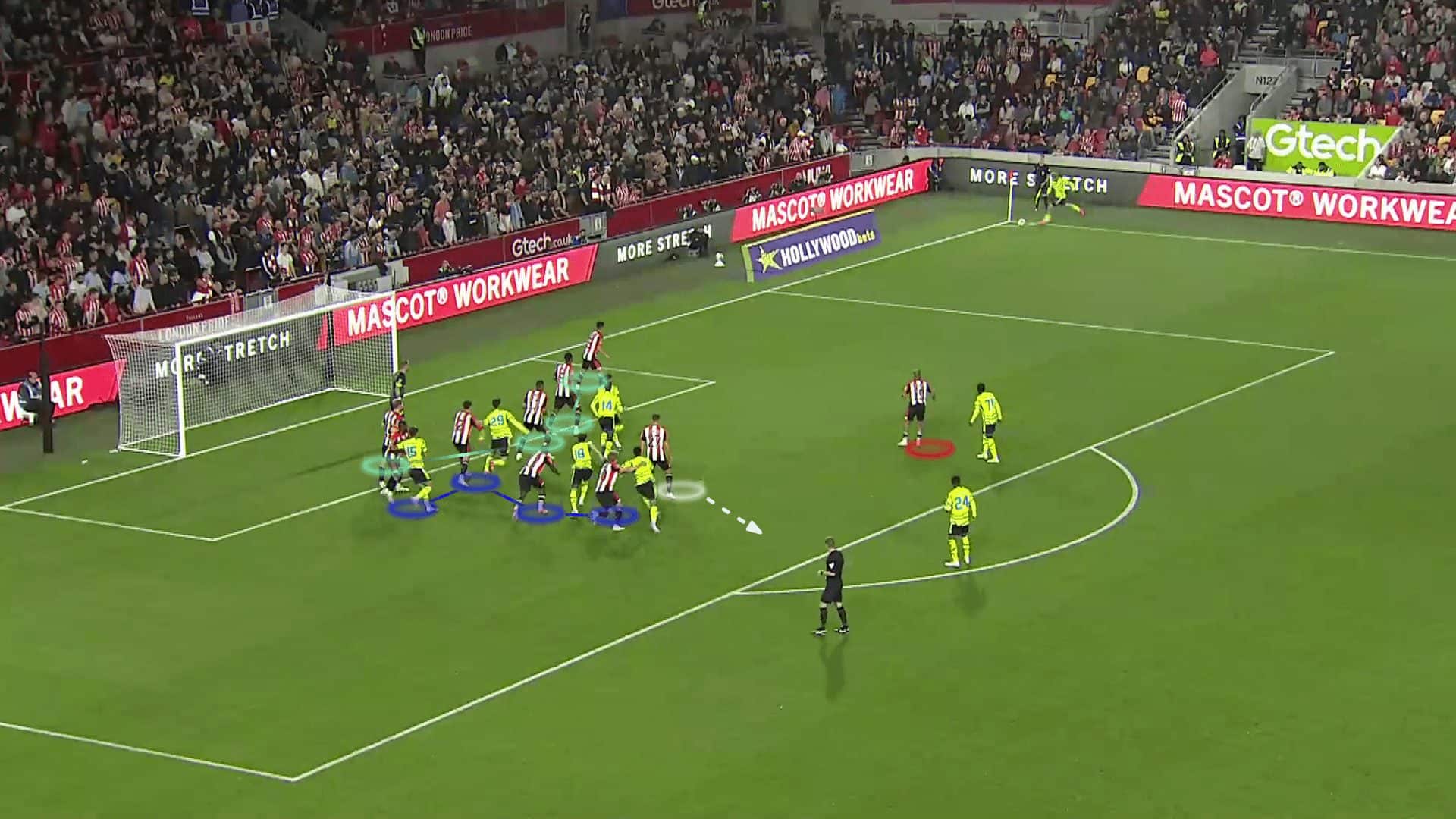
So it is clear that man-markers track their attackers, so the defenders are in a good numerical situation, as shown below.
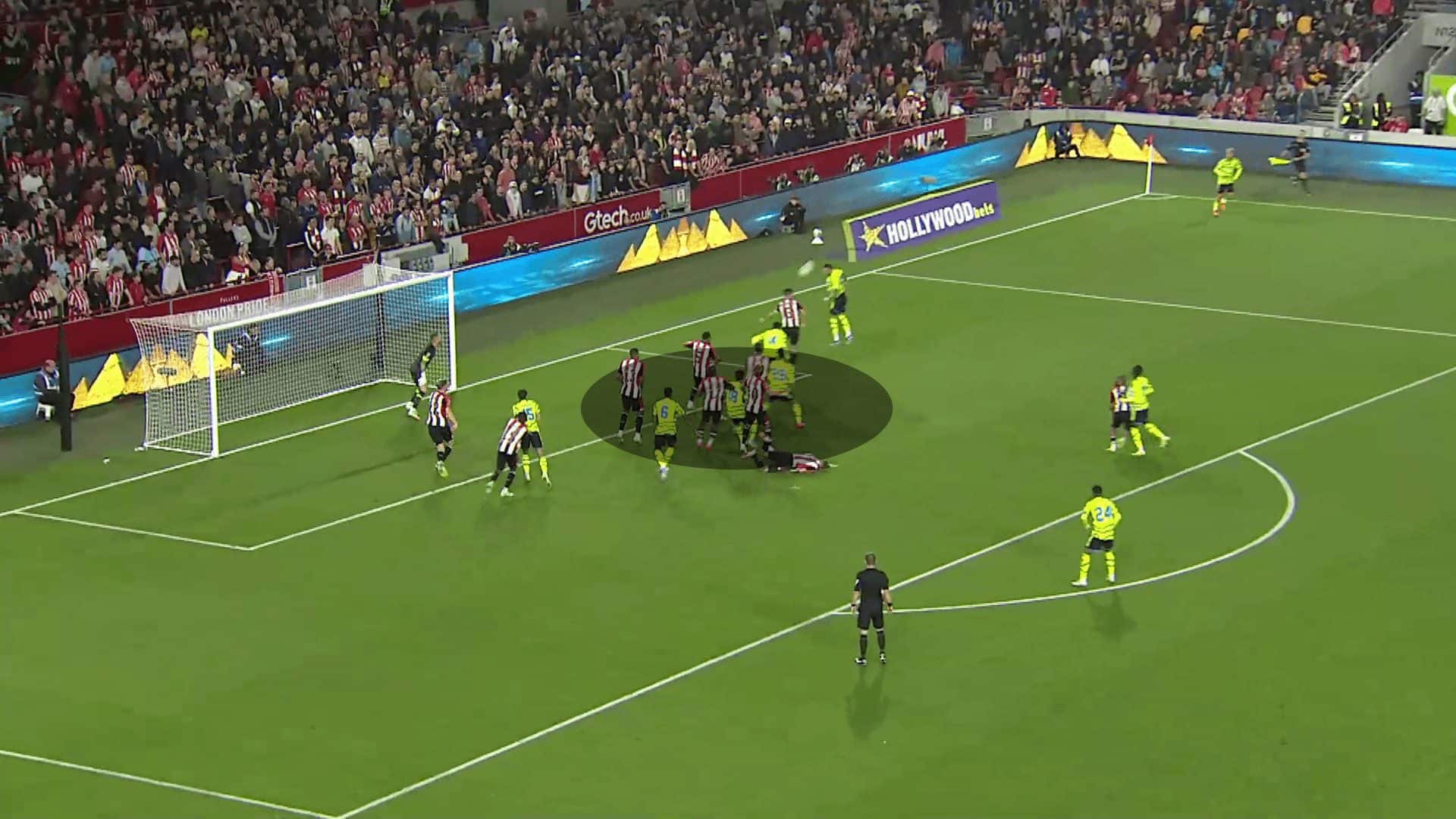
One of these solutions against this far-post pack is a man-marking defending system because of the same previous reason, but in a more precise way because every attacker drags his marker with him, so overloading any area doesn’t mean a numerical mismatch, as shown in the following two photos.
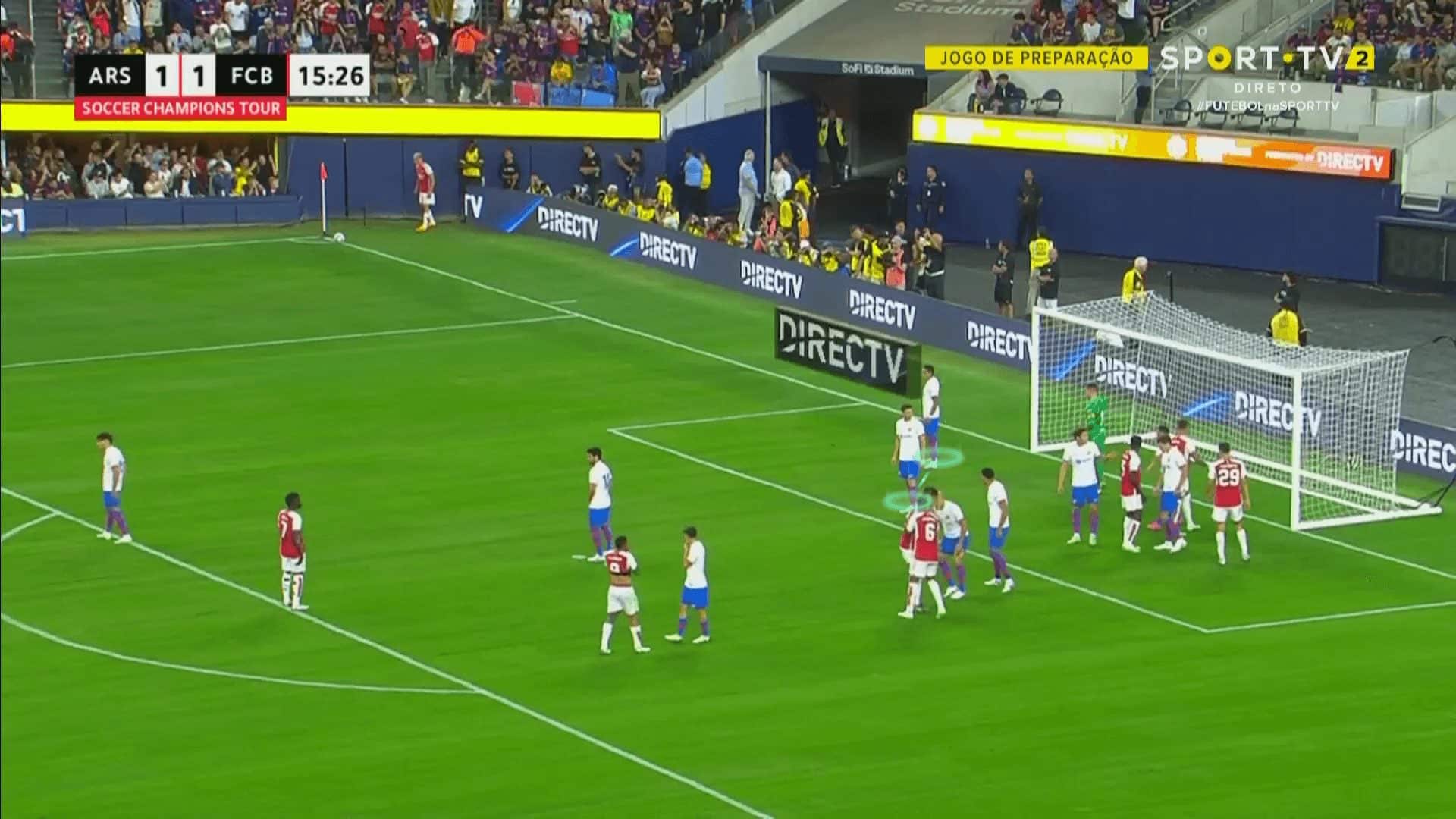

So the goalkeeper can punch the ball away during the conflict between the attackers and their markers.
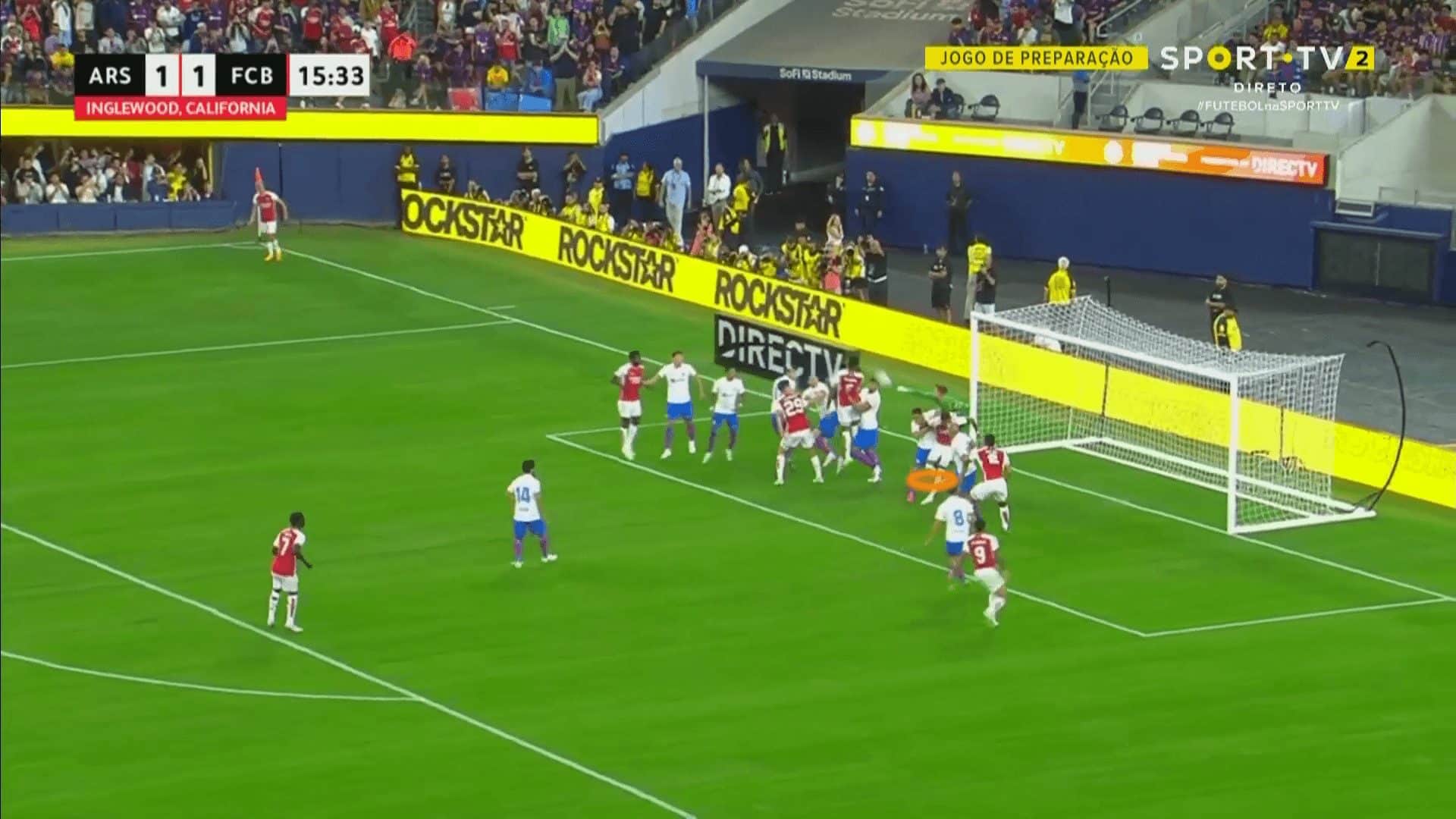
Against man-marking defending system
Gunners have dealt with that by using underloading instead of overloading. Let’s know how!
In the first photo below, Arsenal’s attackers are on the far post, then they underload this area going to the near post to leave Gabriel Jesus in a 1-v-1 situation against his man marker in a large area, knowing that he is better than him in aerial duels which is a mismatch, as shown in the second and third photos, but the goalkeeper saves the ball, as in the fourth photo.
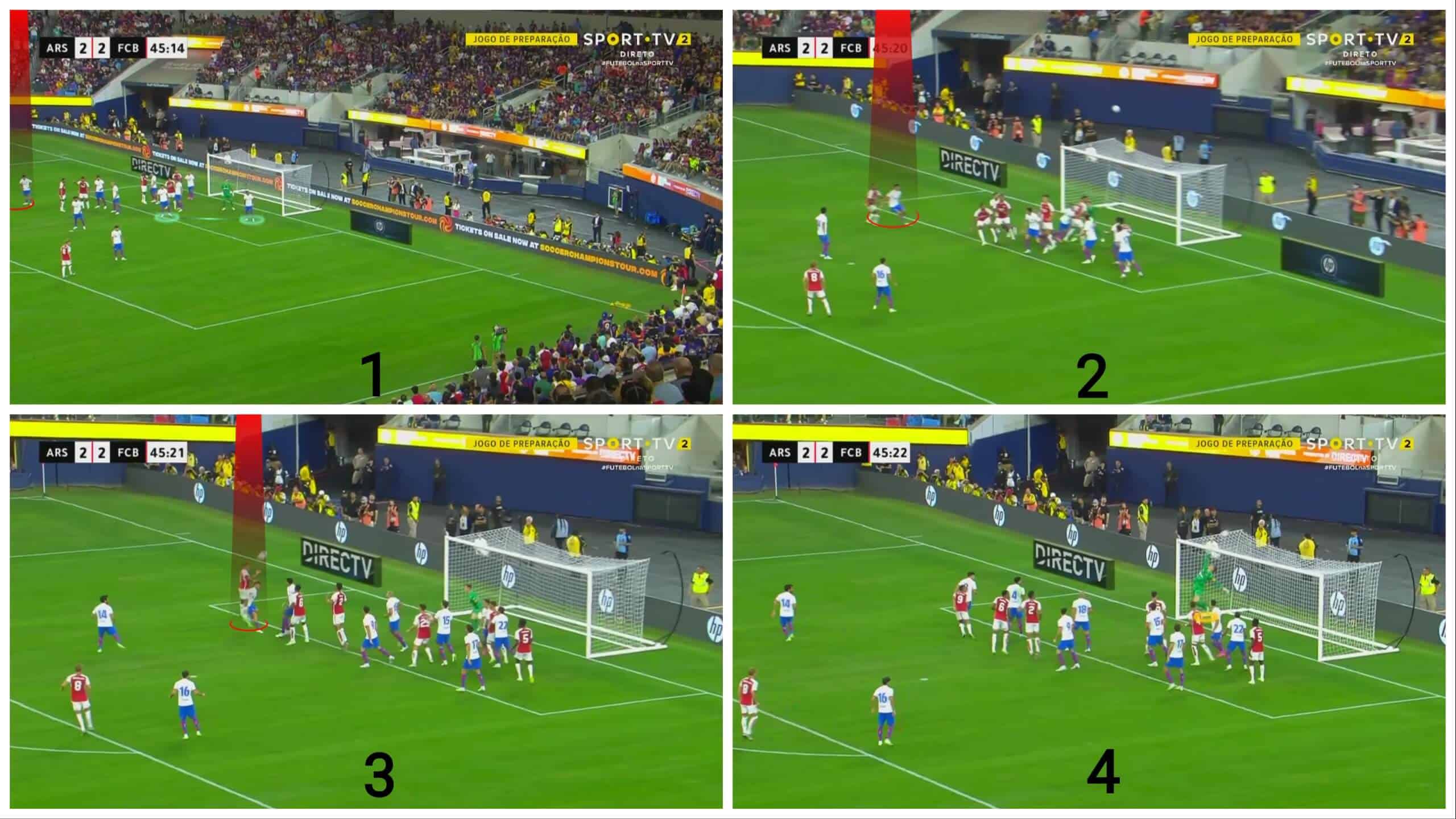
As we will explain, they also use underloading to empty the far post for the player who will receive the flick.
In the first photo, the player who will go to flick the ball on the near post uses a good trick, which is giving his back to the ball at first, pretending that his role is to block or something else, then he moves suddenly on the near post before his marker, as shown in the second and third photos, while the second targeted player starts to move to the underloaded area exploiting that his marker focuses on the first touch.
Ben White also has an important role: blocking the goalkeeper to prevent him from getting the headed pass, as shown in the fourth photo.
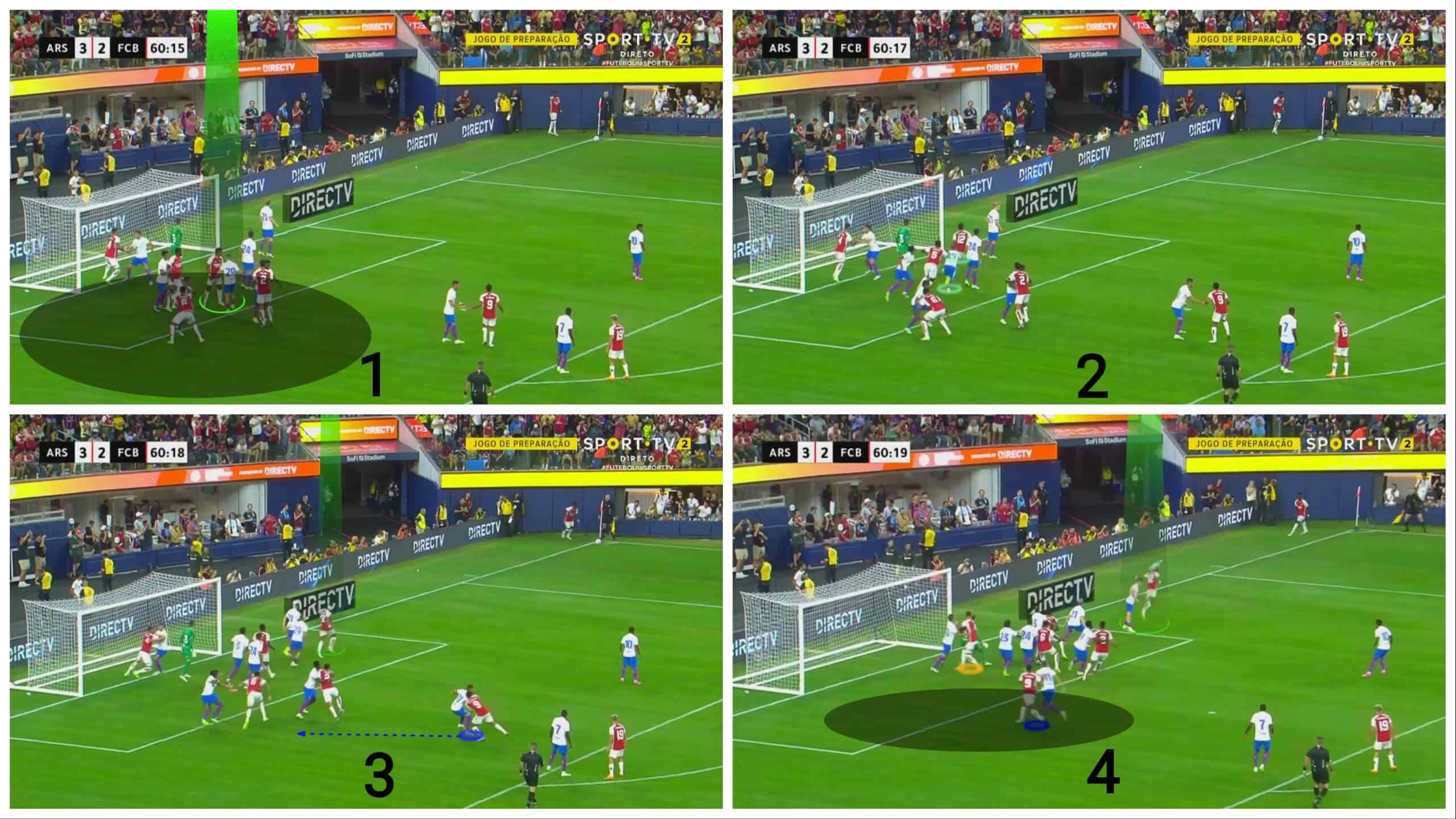
But the ball hits the first player’s back, not the head, so it goes behind the second targeted player, as shown below.
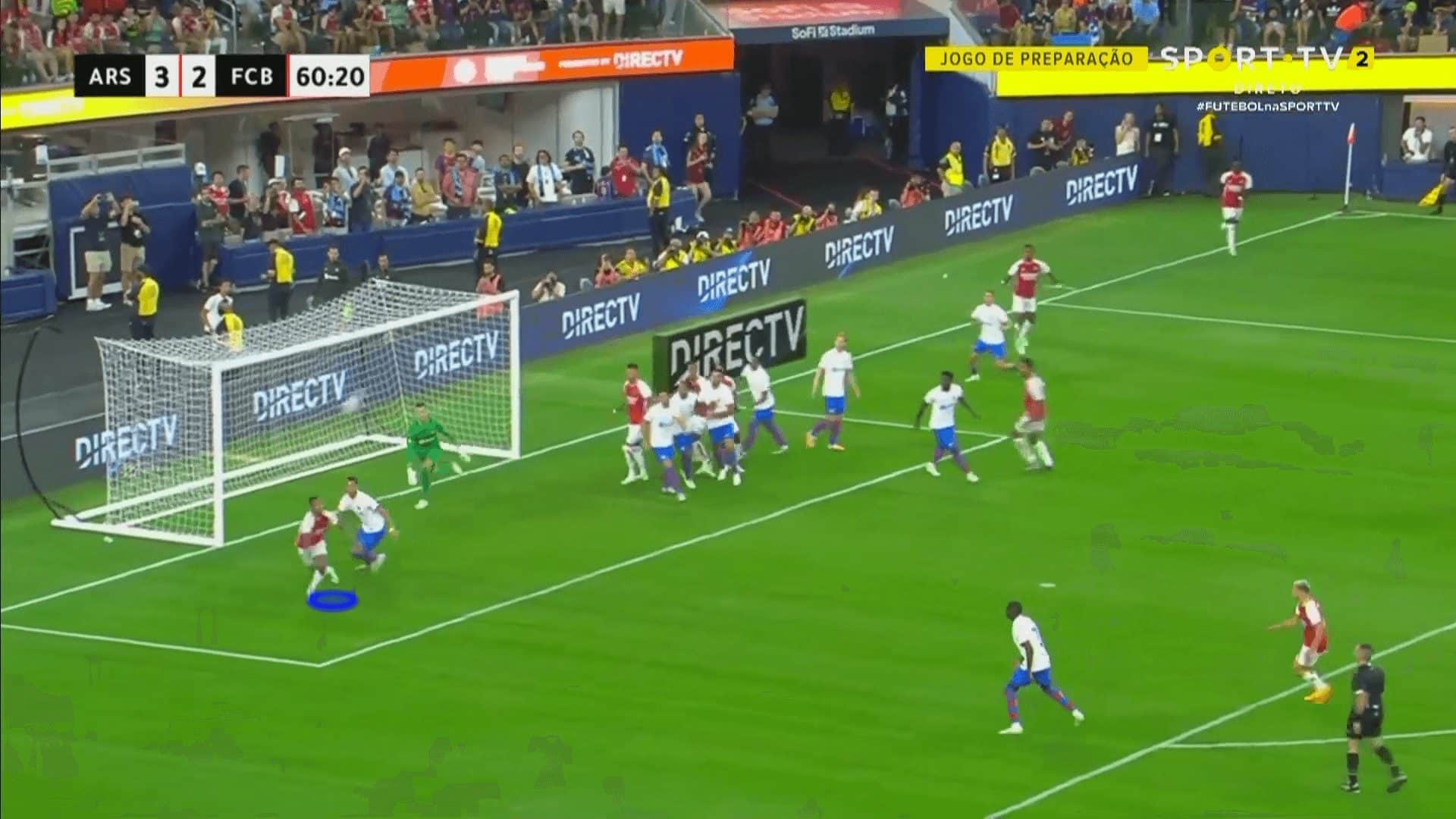
Conclusion
In this analysis, we have shown many tactics that Arsenal have used in their attacking corners and how they are the team to score goals from corners in this Premier League season by six goals, knowing how they deal with the different defending systems in various and diverse ways.

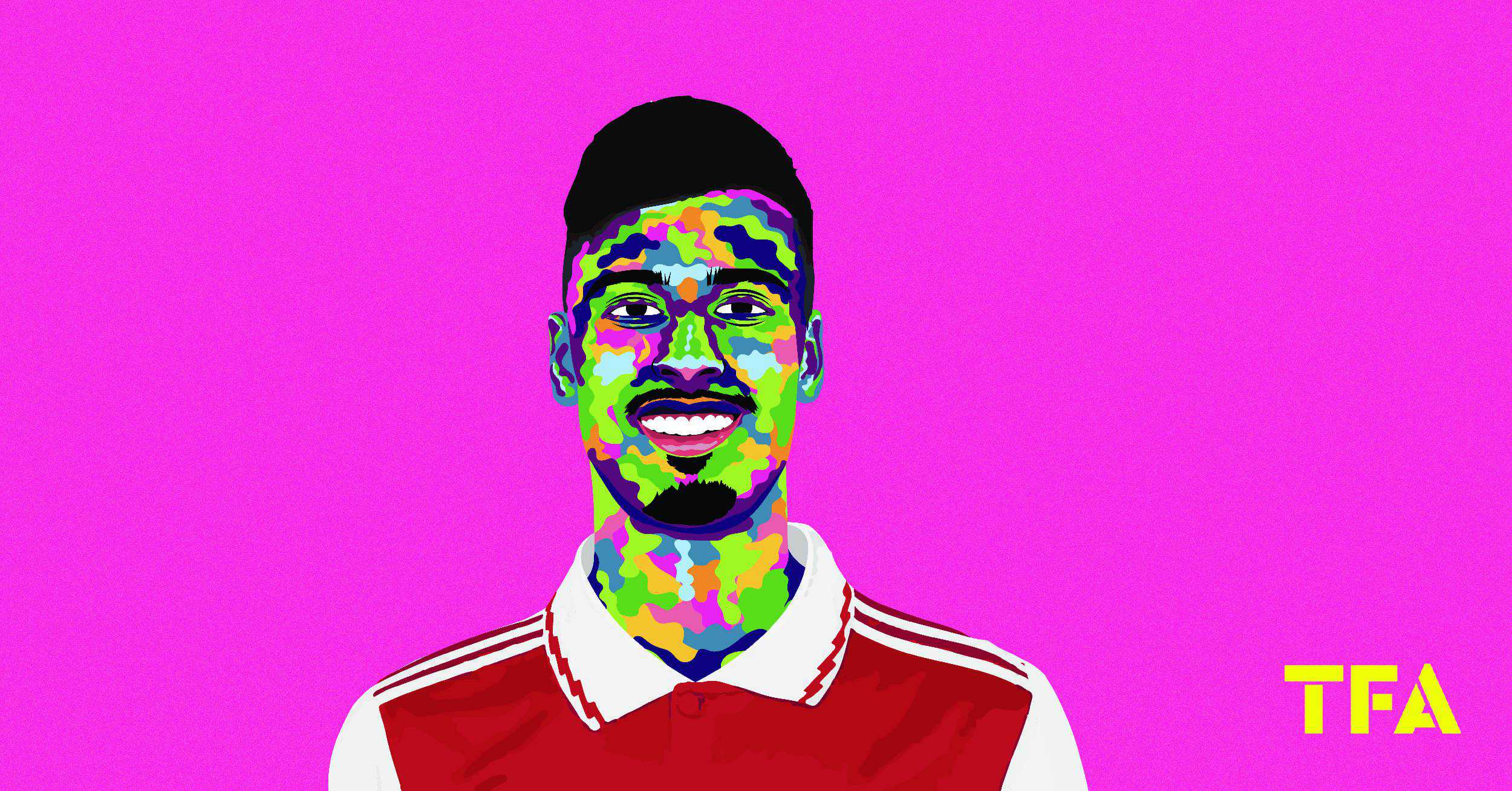




Comments